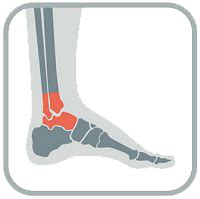Frequently, people experience a sensation of instability in their ankle when walking on uneven surfaces or stepping off a curb. This condition is known as chronic ankle instability and can be caused by incomplete healing from a previous ankle sprain. The ankle may feel weak and have impaired postural control, leading to repeated episodes of instability.
What causes your ankle to suddenly give way?
Ankle instability is a common issue that is typically caused by repeated sprains. These sprains can weaken the ankle tissue and ligaments, leading to instability. However, it’s important to note that it’s not necessarily the sprains themselves that cause the instability, but rather the lack of proper joint rehabilitation during the healing process. This is why it’s crucial to seek proper medical attention and follow a rehabilitation plan to prevent future ankle instability.
How do I stop my ankle from giving out?
If you are experiencing ankle instability or your ankle keeps giving out, there are several things you can do to prevent it. First, try to strengthen the muscles around your ankle by doing exercises such as calf raises, ankle circles, and resistance band exercises. Additionally, wearing supportive shoes with good arch support and ankle stability can help prevent ankle sprains. If you have already experienced an ankle sprain, consider wearing an ankle brace or support during physical activity.
It is also important to stretch before and after exercise to prevent muscle tightness and improve flexibility. If your ankle instability persists, consult with a healthcare professional for further evaluation and treatment options.
What are weak ankles a symptom of?
Weak ankles can be caused by a variety of factors, such as sprains, strains, fractures, and dislocations. Chronic ankle instability is another issue that can lead to weak ankles, which often develops after an ankle injury. In addition, certain health conditions can also contribute to weak ankles, with diabetes and osteoarthritis being the most prevalent. It’s important to address weak ankles promptly to prevent further injury and discomfort.
What are the signs of ankle instability?
Ankle instability is a condition where the ankle joint is unable to maintain its normal position during movement, leading to frequent sprains and discomfort. The signs of ankle instability include recurrent ankle sprains, a feeling of giving way or instability in the ankle, swelling, tenderness, and pain. Other symptoms may include difficulty walking on uneven surfaces, weakness in the ankle, and a limited range of motion. If you experience any of these symptoms, it is important to seek medical attention to prevent further damage and to receive proper treatment.
Physical therapy, bracing, and strengthening exercises are common treatments for ankle instability.
How do you strengthen an unstable ankle?
There are several ways to strengthen an unstable ankle. One effective method is to perform exercises that focus on improving balance and stability, such as standing on one leg or using a balance board. Strengthening the muscles around the ankle, such as the calf muscles and the muscles on the outside of the ankle, can also help improve stability. Additionally, wearing supportive shoes or ankle braces can provide extra support and prevent further injury.
It’s important to consult with a healthcare professional before starting any new exercise program, especially if you have a history of ankle injuries.
Why is my ankle so unstable?
Chronic ankle instability is often caused by an untreated sprain that was not given enough time to heal before weight was put on it. Additionally, it can occur when someone experiences multiple ankle sprains. This condition is particularly prevalent among athletes who participate in high-impact sports.
Why does my foot give way when I walk?
Foot drop is typically caused by the compression of the peroneal nerve in the leg, which controls the muscles responsible for lifting the foot. This compression can occur due to a serious knee injury or as a result of hip or knee replacement surgery. It’s important to address foot drop promptly, as it can lead to difficulty walking and an increased risk of falls.
Does ankle instability go away?
It’s important to understand that chronic ankle instability is a persistent issue that may not resolve on its own. While rest, ice, compression, and elevation can offer temporary relief from the pain caused by an ankle sprain, they won’t actually repair any damaged ligaments. In some cases, surgery may be required to fully address the problem.
Can you cure ankle instability?
“`If left untreated, chronic ankle instability can cause a host of problems. However, the condition is typically caused by an acute injury and can be effectively treated with non-surgical therapies. This is great news for those suffering from chronic ankle instability, as they can find relief without undergoing surgery.“`
What are the two types of ankle instability?
Chronic ankle instability can manifest in two forms: functional instability and mechanical instability. Functional instability is characterized by patient-reported symptoms and complaints, often accompanied by clinical laxity. On the other hand, mechanical instability can be identified through physical examination. It’s important to differentiate between the two types of instability in order to properly diagnose and treat the condition.
What is the best way to stabilize your ankle?
If you’ve suffered a sprained ankle, your doctor may suggest using an elastic bandage, sports tape, or an ankle support brace to stabilize the affected area. For more severe sprains, a cast or walking boot may be required to immobilize the ankle and promote healing. It’s important to follow your doctor’s recommendations to ensure proper healing and prevent further injury.
How common is ankle instability?
Every year, around two million people in the United States suffer from lateral ankle sprains. These sprains typically affect one or more of the three ligaments in the ankle: the anterior talofibular ligament (ATFL), the calcaneofibular ligament (CFL), and the posterior talofibular ligament (PTFL). Ankle sprains can be painful and limit mobility, making it important to seek proper treatment and take steps to prevent future injuries.
Can an MRI show ankle instability?
MRI is often suggested for surgical planning in cases of chronic ankle instability, despite its low sensitivity. This is because MRI has a wide range of diagnostic capabilities, making it a valuable tool for identifying potential issues. However, it’s important to note that MRI may not always detect all problems, so additional testing or evaluation may be necessary.
Can being overweight cause ankle instability?
Carrying excess weight can have a negative impact on your physical health in many ways. One of these is an increased risk of spraining your ankle. This is because the additional weight puts more pressure on your joints, making them less stable and reducing your ability to control your balance. It’s important to maintain a healthy weight to reduce your risk of injury and improve your overall health.
Will losing weight help with weak ankles?
Maintaining a healthy weight is crucial for the overall health of your body, including your ankles. Being overweight can cause additional stress on your lower extremities, from your hips to your knees, ankles, and feet. This added pressure can lead to weak ankles and other related issues. By shedding extra pounds, you can reduce the strain on your ankles and alleviate the burden placed on your legs and feet.
Therefore, losing weight can be an effective way to relieve ankle pain and improve your overall well-being.
What does loose body in ankle mean?
Loose bodies refer to bone or cartilage fragments that have broken off within the joint. If these fragments are not removed, they can cause damage to the joint surface, leading to pain and limited ankle movement. Fortunately, your surgeon can perform a procedure to remove these loose bodies from the joint. By doing so, normal and smooth ankle motion can be restored, providing relief from discomfort and improving overall joint function.
Is my weight affecting my ankles?
Carrying excess weight can cause added stress on the tendons, bones, and ligaments in your ankle. As weight-bearing joints, ankles are particularly susceptible to discomfort and pain when there is an increase in body weight. Obesity can disrupt the natural movement and functioning of your ankle, which can result in chronic ankle pain.
Does ankle instability go away?
It’s important to understand that chronic ankle instability is a persistent issue that may not resolve on its own. While rest, ice, compression, and elevation can offer temporary relief from the pain caused by an ankle sprain, they won’t actually repair any damaged ligaments. In some cases, surgery may be required to fully address the problem.
Can you cure ankle instability?
“`If left untreated, chronic ankle instability can cause a host of problems. However, the condition can be effectively treated with non-surgical therapies. Typically, chronic ankle instability is the result of an acute injury. The good news is that there are many options available to help alleviate the symptoms and prevent further damage.
“`
How do you know if your ankle fracture is unstable?
When it comes to assessing ankle injuries, imaging studies like X-rays are crucial. They not only confirm the presence of a fracture but also help determine the stability of the injury. This information is essential in deciding the appropriate course of treatment. X-rays are a non-invasive and relatively quick procedure, making them a popular choice for diagnosing ankle injuries.
With the help of imaging studies, healthcare professionals can provide accurate and effective treatment plans for their patients.
What are the two types of ankle instability?
Chronic ankle instability can manifest in two forms: functional instability and mechanical instability. Functional instability is characterized by patient-reported symptoms and complaints, often accompanied by clinical laxity. On the other hand, mechanical instability can be identified through physical examination. It’s important to differentiate between the two types of instability in order to properly diagnose and treat the condition.
Related Article
- Why Does My Aloe Plant Stink?
- Why Does My Alexa Randomly Beep?
- Why Does My Alexa Keep Beeping?
- Why Does My Alexa Beep Randomly?
- Why Does My Airtag Randomly Beep?
- Why Does My Airtag Not Update?
- Why Does My Airpod Keep Beeping?
- Why Does My Air Purifier Smell?
- Why Does My Ac Short Cycle?
- Why Does My Ac Say Wait?


